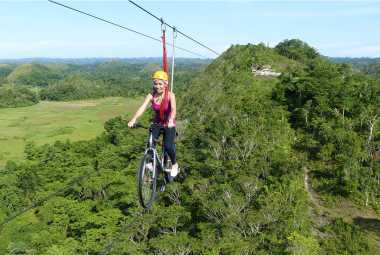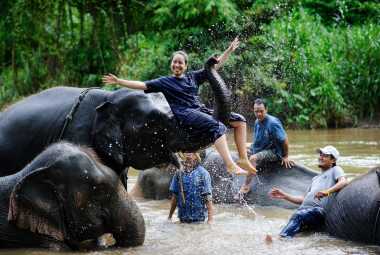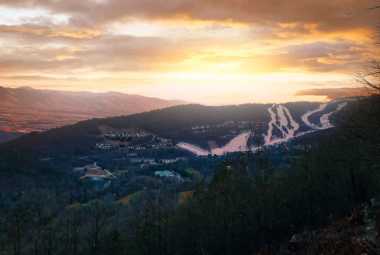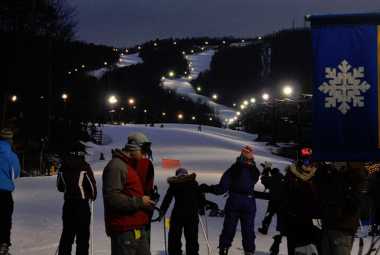Image by PS/Lian Law/Public Domain
*Vacation Mode is a for-profit site. It contains paid banner advertisements that are generated and managed by a third-party network. This site also includes relevant affiliate links (both in the content and on the sidebar) all of which we do our best to clearly mark as such.
Quick Summary
-
Introduction to Dark-sky Destinations
- Dark-sky destinations are areas with minimal light pollution, perfect for stargazing and astronomical observations.
- These locations are favored by astronomy enthusiasts and offer a chance to see the night sky in its full glory, including constellations, meteor showers, and the Milky Way.
-
Joshua Tree National Park as a Dark-sky Destination
- Joshua Tree National Park, located in California, is celebrated for its natural darkness, making it an ideal place for viewing the Milky Way and other celestial bodies.
- The park's minimal light pollution, coupled with its high elevation and clear desert air, facilitates excellent stargazing and astrophotography opportunities.
- Efforts to reduce light pollution include using shielded outdoor lights and promoting dark-sky friendly lighting among visitors.
-
Benefits of Visiting a Dark-sky Destination
- Enhanced stargazing experience, with clear views of meteor showers, star clusters, and the Milky Way.
- Opportunities for astrophotography, capturing stunning images of the night sky.
- A deeper connection to nature and a push towards conservation efforts to preserve dark skies.
-
Activities at Joshua Tree National Park
- Stargazing programs and events, including ranger-led astronomy programs and star parties.
- Hiking trails and camping opportunities that offer unique night-sky viewing experiences.
- Wildlife viewing, especially of nocturnal animals, enhancing the overall experience of the park's natural wonders.
-
Packing for a Dark-sky Destination Trip
- Essential items include appropriate clothing for nighttime, a red flashlight to preserve night vision, and star maps for celestial navigation.
- Recommendations include bringing a comfortable camping chair, a telescope or binoculars for night-sky observations, and a skywatching guidebook.
-
Preserving Dark Skies at Joshua Tree National Park
- Visitors are encouraged to follow Leave No Trace principles, use dark-sky friendly lighting, and support conservation efforts.
- These practices help minimize light pollution, benefiting nocturnal wildlife and ensuring visitors can enjoy the park's celestial displays.
-
FAQs
- The best time for stargazing in Joshua Tree is during a new moon.
- The park has designated dark-sky viewing areas like Black Rock and Cottonwood Campgrounds.
- Visitors can see a variety of celestial objects, including planets, stars, and galaxies.
- Guided stargazing tours are available, and essential items for a trip include warm clothing, a red light flashlight, and star charts.
Have you ever heard of a dark-sky destination?
We explore what makes Joshua Tree National Park one of these unique places. From its location and climate to efforts to reduce light pollution, this park offers an unparalleled stargazing experience. Discover the benefits of visiting a dark-sky destination, the activities available at Joshua Tree National Park, and what you should bring for your trip.
Learn how you can help preserve the dark skies at this stunning park. Get ready for an adventure unlike any other!
What Is a Dark-Sky Destination?
A Dark-sky destination refers to a location characterized by natural darkness, ideal for stargazing, astronomical observation, and immersing oneself in the wonders of the night sky and astronomy.
These destinations are sought after by astronomy enthusiasts and stargazers who yearn to witness the celestial ballet undisturbed by light pollution. In these tranquil settings, one can marvel at the intricate dance of constellations, trace the path of shooting stars, and maybe even catch a glimpse of the elusive Milky Way stretching across the velvety expanse above. Dark-sky locations provide a rare opportunity to connect with the cosmos, fostering a deep appreciation for the vastness of the universe and our place within it.
The Best Stargazing in Joshua Tree National Park
Video by Explore. Travel. Capture.
Why Is Joshua Tree National Park a Dark-Sky Destination?
Joshua Tree National Park in California stands out as a premier dark-sky destination due to its exceptional natural darkness, offering unparalleled views of the Milky Way, celestial bodies, and a mesmerizing night sky.
The park's minimal light pollution, coupled with its high elevation and clear desert air, creates an ideal environment for stargazing and astrophotography. Visitors can witness stunning meteor showers, planetary alignments, and even the occasional appearance of the International Space Station passing overhead. With designated stargazing areas and ranger-led astronomy programs, Joshua Tree provides a unique opportunity for night-sky enthusiasts to delve into the wonders of the universe amidst a serene and otherworldly landscape.
Location and Climate
Situated in the Mojave Desert, Joshua Tree National Park's location and arid climate create optimal conditions for observing celestial objects, and phenomena and experiencing the magic of the night sky.
The vast expanse of desert terrain in Joshua Tree National Park, with its minimal light pollution and clear skies, offers stargazers an uninterrupted view of the cosmos. This remote location allows visitors to witness meteor showers, planetary alignments, and the shimmering Milky Way in all its glory.
The park's elevation provides an advantageous vantage point for spotting celestial wonders like distant galaxies and nebulae. The juxtaposition of rugged desert landscapes against the backdrop of a star-strewn sky adds an enchanting element to stargazing experiences in this unique natural setting.
Efforts to Reduce Light Pollution

Efforts to combat light pollution at Joshua Tree National Park have led to its designation as a dark-sky preserve, showcasing the park's commitment to dark-sky conservation and preserving natural darkness for astronomical observations.
The measures implemented in the park to reduce light pollution range from using shields on outdoor lights to minimize upward light leakage to promoting responsible nighttime lighting practices among visitors. The park has also replaced traditional lighting fixtures with dark-sky-friendly options, such as low-glare LEDs, to limit light spillage. These initiatives not only benefit stargazing and astronomical research within the park but also support the overall ecosystem health by mitigating the disruptive effects of artificial light on nocturnal wildlife.
What Are the Benefits of Visiting a Dark-sky Destination?
Visiting a Dark-sky destination offers unparalleled benefits, including an enhanced stargazing experience, encounters with astronomical wonders, and the opportunity to indulge in mesmerizing night-sky viewing.
Being in a location where city lights are minimal or non-existent allows visitors to witness the magnificent display of stars like never before. The unobscured view of the night sky at dark-sky destinations means you can observe celestial phenomena such as meteor showers, the Milky Way, and even the elusive northern lights with crystal-clear clarity. These sights evoke a sense of awe and perspective, reminding us of our place in the vast expanse of the universe, making stargazing not just an activity but a profound, soul-stirring experience.
Enhanced Stargazing Experience
One of the significant benefits of visiting a Dark-sky destination is the enhanced stargazing experience, allowing for breathtaking views of star clusters, meteor showers, and the amplification of night vision under natural darkness.
The lack of light pollution in these remote locations provides unparalleled opportunities for observing the night sky in its full glory. As you gaze upwards, you may witness shooting stars streaking across the heavens or catch a glimpse of the Milky Way stretching like a luminous pathway. With your eyes adjusted to the darkness, each detail of the celestial canvas becomes more pronounced, revealing intricate patterns and constellations that are often obscured by urban lights. Dark-sky destinations truly offer a portal to the wonders of the universe.
Opportunities for Astrophotography
Dark-sky destinations provide excellent opportunities for astrophotography enthusiasts to capture the beauty of the night sky through stunning images, including star trails and captivating night sky photography, often complemented by astrophotography workshops.
These remote locations offer a clear view of the celestial wonders above, away from light pollution, allowing photographers to capture the Milky Way in all its glory or witness meteor showers with unparalleled clarity.
Enthusiasts can set up their equipment to photograph constellations, planets, and other astronomical sights, creating breathtaking compositions under the vast, dark canvas of the night sky.
Attending astrophotography workshops in such serene settings can provide valuable insights and techniques for enhancing one's skills in capturing the magic of the universe through photography.
Connection to Nature and Conservation
Visiting a Dark-sky destination fosters a profound connection to nature through immersive experiences under natural darkness, instilling a sense of appreciation for the beauty of the night sky and promoting awareness about dark-sky conservation efforts.
This connection to the starlit sky and the peaceful ambiance of dark-sky locations can spark a deep-rooted passion for preserving the natural darkness that is essential for nocturnal wildlife and overall ecosystem health. By experiencing the enchanting celestial display free from light pollution, individuals are inspired to support conservation initiatives aimed at safeguarding these pristine environments. These destinations serve as living classrooms, educating visitors on the detrimental effects of artificial lighting and the urgent need to protect the sanctity of the night sky for future generations.
What Are the Activities Available at Joshua Tree National Park?

Joshua Tree National Park offers a diverse range of activities, including stargazing programs, hiking adventures amidst stunning landscapes, and opportunities for wildlife viewing in their natural habitat.
Visitors to the park can partake in guided stargazing programs that offer unparalleled views of the night-time landscape, with expert astronomers pointing out constellations and celestial phenomena.
Hiking enthusiasts can explore the park's well-maintained trails, such as the popular Hidden Valley trail or the challenging Ryan Mountain hike, showcasing the unique rock formations and desert flora.
Wildlife enthusiasts can spot nocturnal creatures like coyotes, owls, and bats in their natural habitat, enhancing the overall experience of immersing oneself in the park's natural wonders.
Stargazing Programs and Events
Engaging in stargazing programs and events at Joshua Tree National Park provides an enriching experience, offering insights into celestial wonders, star parties, and valuable astronomy education.
These programs cater to astronomy enthusiasts of all levels, from beginners to seasoned stargazers, fostering a sense of community among those who share a passion for the night sky. Educational workshops delve into the science behind stars, planets, and galaxies, allowing participants to deepen their understanding of the universe. Star parties, set against the backdrop of the park's dark skies, offer unforgettable experiences of observing constellations, planets, and even meteor showers.
The park's commitment to promoting astronomy events reflects its dedication to spreading awareness about the importance of preserving dark skies for future generations.
Hiking and Camping
Exploring the hiking trails and camping grounds at Joshua Tree National Park offers a unique perspective, allowing for immersive experiences in natural darkness and revealing dark-sky locations ideal for stargazing.
One of the remarkable aspects of embarking on nocturnal adventures in this desert wilderness is the enhancement of your night vision, enabling you to witness the celestial wonders above with unparalleled clarity. As the sun sets behind the rocky outcrops and Joshua trees, the sky transforms into a canvas sprinkled with countless stars, planets, and even the elusive Milky Way. Gazing upwards from the comfort of your camping spot, you may catch glimpses of shooting stars streaking across the vast expanse, creating a magical and awe-inspiring atmosphere."
Wildlife Viewing
Witnessing wildlife in their natural habitat at Joshua Tree National Park provides an enchanting experience, complemented by celestial viewing opportunities and memorable night-sky experiences.
As the crimson desert sun dips below the horizon, the nocturnal creatures of Joshua Tree emerge from their daytime hiding spots. Under the twinkling canvas of stars, visitors can witness the mesmerizing dance of night-blooming flowers attracting pollinators or listen to the haunting calls of desert owls echoing through the desert landscape.
Stargazing events and guided night walks offered at the park allow guests to delve deeper into the mysteries of the cosmos while connecting with the intricate web of life that thrives in the dark hours.
What Should You Bring for a Dark-sky Destination Trip?

Preparing for a Dark-sky destination trip requires packing essential items such as appropriate clothing for night-time conditions, a red flashlight to preserve night vision, and star maps for celestial navigation.
In addition to these key items, don't forget to bring a comfortable camping chair for stargazing sessions and a quality telescope or binoculars to enhance your night-sky observations. It is also beneficial to have a skywatching guidebook to learn about different celestial objects you may encounter during your night excursions. Packing extra batteries for your flashlight and electronic devices is crucial to avoid running out of power during these dark-sky adventures. Remember, being well-prepared will ensure a memorable and enriching experience under the starlit skies.
Proper Clothing and Gear
Selecting proper clothing and gear tailored for dark-sky destinations is crucial to enhance the night-sky experience, ensure comfort during stargazing activities, and preserve night vision for optimal celestial viewing.
Appropriate attire not only shields against the chill of nighttime skies but also minimizes distractions that could hinder the awe-inspiring beauty of the starlit heavens.
Opting for dark, non-reflective clothing helps maintain the darkness of the surroundings, crucial for visible astronomical sights.
Wearing layers allows visitors to adjust to temperature changes that often occur in open stargazing terrains.
Comfortable footwear ensures ease of movement when transitioning from one cosmic marvel to another, enhancing the overall experience of exploring the mysterious wonders of the night sky.
Red Flashlight
Bringing a red flashlight to a dark-sky destination is essential for night photography, as it helps maintain night vision, preserves natural darkness, and facilitates exploration of prime stargazing locations.
Red flashlights emit a dimmer light compared to white lights, making them ideal for preserving night vision and preventing light pollution in areas designated for stargazing. These flashlights are particularly useful when navigating through rugged terrain to reach optimal stargazing spots without disturbing the surrounding environment. By using a red flashlight, astronomers and night photographers can adjust camera settings or consult star charts while minimizing their impact on the night-sky ecosystem, ensuring an undisturbed view of celestial objects.
Star Maps and Guidebooks
Carrying star maps and guidebooks to a dark-sky destination enhances the astronomical experience, providing valuable insights into celestial navigation, astronomical phenomena, and enriching astronomy education.
These tools act as essential companions, helping observers locate and identify key celestial bodies such as constellations, planets, and stars. By referencing star maps, individuals can track the movements of notable astronomical events like meteor showers, eclipses, and planetary alignments. Guidebooks offer detailed explanations of these phenomena, offering in-depth knowledge that fosters a deeper connection with the wonders of the night sky. Through the use of these resources, sky gazers can delve into the rich tapestry of celestial discoveries and engage more meaningfully with the universe."
How Can You Help Preserve Dark Skies at Joshua Tree National Park?
Contributing to the preservation of dark skies at Joshua Tree National Park involves following Leave No Trace principles, utilizing dark-sky friendly lighting, and actively supporting conservation efforts to safeguard the natural beauty of the night sky.
Incorporating these practices can help reduce light pollution, which not only benefits nocturnal wildlife but also allows visitors to experience the park's enchanting celestial displays in their full glory. By minimizing artificial light sources and opting for shielded fixtures, individuals can play a crucial role in maintaining the darkness of the night sky. Participation in organized stargazing events and educational programs can enhance awareness about the importance of dark-sky conservation and foster a deeper connection to the cosmic wonders above.
Follow Leave No Trace Principles
Adhering to Leave No Trace principles at Joshua Tree National Park is vital for dark-sky preservation, conservation efforts, and maintaining the park's status as a dark-sky sanctuary for astronomical pursuits.
By following these principles, visitors can minimize their impact on the environment and help reduce light pollution, ensuring that the night sky remains unspoiled for stargazing and scientific research. The park's designation as a dark-sky sanctuary underscores the significance of protecting the natural darkness of the night sky, promoting awareness of the importance of preserving these pristine celestial views. Conservation efforts at Joshua Tree National Park play a crucial role in safeguarding the nocturnal habitat of numerous species and maintaining the ecological balance in the region.
Use Dark-sky Friendly Lighting
Employing dark-sky friendly lighting practices at Joshua Tree National Park is essential to combat light pollution, protect dark-sky locations, and ensure optimal conditions for stargazing and celestial observations.
By implementing these lighting techniques, not only do we safeguard the natural habitats of nocturnal animals and preserve the intricate ecosystems within the park, but we also contribute to reducing energy consumption and promoting sustainable practices.
Visitors can immerse themselves in the tranquil beauty of the night sky, marveling at the vast expanse of stars, planets, and constellations, fostering a deeper connection to the universe and igniting a sense of wonder and curiosity.
Dark-sky conservation efforts serve as a beacon of hope for future generations, highlighting the importance of environmental stewardship and maintaining the authenticity of natural landscapes for astronomical tourism.
Support Conservation Efforts
Supporting conservation efforts at Joshua Tree National Park plays a pivotal role in dark-sky preservation, fostering awareness about the importance of natural darkness, and contributing to the sustainability of dark-sky initiatives.
One way individuals can actively support these endeavors is by participating in organized stargazing events within the park, which not only educates visitors about the significance of preserving dark skies but also helps reduce light pollution. People can volunteer for night sky monitoring programs aimed at tracking changes in light levels around the park, providing valuable data for conservation efforts. By making small changes like using red flashlights and turning off unnecessary outdoor lights, individuals can play a significant part in protecting the dark-sky community at Joshua Tree.
Frequently Asked Questions
1. What makes Joshua Tree National Park a top dark-sky destination?
Joshua Tree National Park is a top dark-sky destination because it has minimal light pollution, making it an ideal spot for stargazing and astrophotography.
2. When is the best time to visit Joshua Tree National Park for stargazing?
The best time to visit Joshua Tree National Park for stargazing is during a new moon, when the sky is at its darkest. You can check the lunar calendar to plan your trip accordingly.
3. Are there any designated dark-sky viewing areas in Joshua Tree National Park?
Yes, there are multiple designated dark-sky viewing areas in Joshua Tree National Park, including Black Rock Campground, Cottonwood Campground, and Keys View.
4. What types of celestial objects can be seen at Joshua Tree National Park?
Visitors to Joshua Tree National Park can see a wide variety of celestial objects, including stars, planets, galaxies, and even the Milky Way.
5. Are there any guided stargazing tours available at Joshua Tree National Park?
Yes, the park offers a variety of guided stargazing tours, including ranger-led programs and private tours with professional astronomers. Reservations may be required for some tours.
6. What should I bring for a stargazing trip to Joshua Tree National Park?
It is recommended to bring warm clothing, a red light flashlight, a star chart or mobile app, and any necessary equipment for astrophotography. It is also important to pack out all trash and leave no trace to preserve the park's dark skies.


















